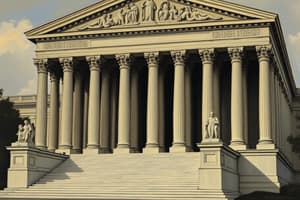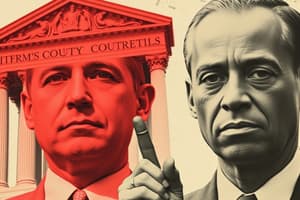Podcast
Questions and Answers
What was established in McCulloch v. Maryland (1819)?
What was established in McCulloch v. Maryland (1819)?
- Elastic clause (correct)
- National supremacy (correct)
- State supremacy
- Implied powers (correct)
The Commerce Clause gives Congress power to regulate guns near state-operated schools according to United States v. Lopez (1995).
The Commerce Clause gives Congress power to regulate guns near state-operated schools according to United States v. Lopez (1995).
False (B)
What does Engel v. Vitale (1962) prohibit?
What does Engel v. Vitale (1962) prohibit?
State-sponsored recitation of prayer in public schools
What was the ruling in Wisconsin v. Yoder (1972)?
What was the ruling in Wisconsin v. Yoder (1972)?
What right was guaranteed in Tinker v. Des Moines (1969)?
What right was guaranteed in Tinker v. Des Moines (1969)?
Freedom of the press is protected according to New York Times v. US (1971).
Freedom of the press is protected according to New York Times v. US (1971).
What does Schenk v. United States (1919) say about free speech?
What does Schenk v. United States (1919) say about free speech?
What right did Gideon v. Wainwright (1963) guarantee?
What right did Gideon v. Wainwright (1963) guarantee?
What issue was addressed in Roe v. Wade (1973)?
What issue was addressed in Roe v. Wade (1973)?
What did McDonald v. Chicago (2010) incorporate?
What did McDonald v. Chicago (2010) incorporate?
What was the significance of Brown v. Board of Education (1954)?
What was the significance of Brown v. Board of Education (1954)?
What does Citizens United v. Federal Election Commission (2010) say about political spending?
What does Citizens United v. Federal Election Commission (2010) say about political spending?
What does Baker v. Carr (1962) establish?
What does Baker v. Carr (1962) establish?
Shaw v. Reno (1993) allowed racial gerrymandering.
Shaw v. Reno (1993) allowed racial gerrymandering.
What did Marbury v. Madison (1803) establish?
What did Marbury v. Madison (1803) establish?
Study Notes
McCulloch v. Maryland (1819)
- Established the principle of national supremacy over states.
- Introduced the concept of implied powers through the elastic clause.
- Clarified that states cannot tax federal institutions, emphasizing "the power to tax involves the power to destroy."
- Chief Justice John Marshall played a significant role in the ruling.
United States v. Lopez (1995)
- Declared that the Commerce Clause does not grant Congress authority to regulate firearms near schools.
- Marked a notable limit on federal power concerning states and educational institutions.
Engel v. Vitale (1962)
- Ruled that state-sponsored prayer in public schools violates the Establishment Clause of the 1st Amendment.
- Reinforced the application of the 1st Amendment through the 14th Amendment's Due Process Clause.
Wisconsin v. Yoder (1972)
- Court found that Wisconsin could not mandate Amish children attend school beyond 8th grade.
- Recognized the importance of religious freedom and long-held beliefs in the educational process.
Tinker v. Des Moines (1969)
- Affirmed students' rights to free speech, allowing them to protest by wearing armbands in schools.
- Set a precedent for student expression within educational settings.
New York Times v. United States (1971)
- Protected freedom of the press against government prior restraint.
- The ruling emphasized a "heavy presumption against prior restraint," bolstering press freedom.
Schenk v. United States (1919)
- Established that speech creating a "clear and present danger" is not protected under the 1st Amendment.
- Set a standard for analyzing the limits of free speech in relation to public safety.
Gideon v. Wainwright (1963)
- Guaranteed the right to legal counsel for defendants who cannot afford an attorney in felony cases.
- Expanded the rights of the accused and reinforced the importance of fair trials.
Roe v. Wade (1973)
- Recognized abortion rights as part of the privacy rights implied in the 14th Amendment.
- The ruling sparked ongoing debates about reproductive rights and privacy laws.
McDonald v. Chicago (2010)
- Incorporated the 2nd Amendment to the states, affirming the right to bear arms beyond federal jurisdiction.
- Strengthened individual gun ownership rights across the country.
Brown v. Board of Education (1954)
- Unanimously ruled that racial segregation in public schools violated the Equal Protection Clause of the 14th Amendment.
- This landmark decision helped dismantle racial segregation in the U.S.
Citizens United v. Federal Election Commission (2010)
- Defined political spending by corporations and unions as a form of protected speech under the 1st Amendment.
- Broadened the scope of campaign financing and influenced future political expenditures.
Baker v. Carr (1962)
- Introduced the principle of "One man, one vote," emphasizing equal representation in legislative districts.
- Required states to ensure legislative districts have roughly equal populations.
Shaw v. Reno (1993)
- Outlawed racial gerrymandering, stating that race cannot be the primary factor in drawing legislative district boundaries.
- Aimed to prevent discrimination and maintain fair electoral processes.
Marbury v. Madison (1803)
- Established the doctrine of judicial review, allowing the Supreme Court to invalidate unconstitutional acts by the legislative or executive branches.
- Set the foundation for the judiciary's role in checking government powers.
Studying That Suits You
Use AI to generate personalized quizzes and flashcards to suit your learning preferences.
Description
This quiz covers 15 landmark Supreme Court cases for AP Government students. Each flashcard includes key concepts and definitions which are essential for understanding the impact of these cases on U.S. law and governance. Master these flashcards to excel in your AP Gov exam.




